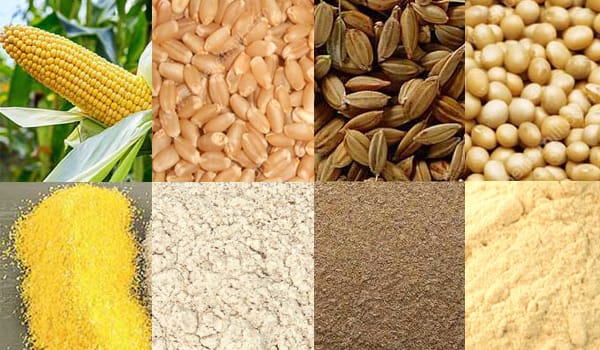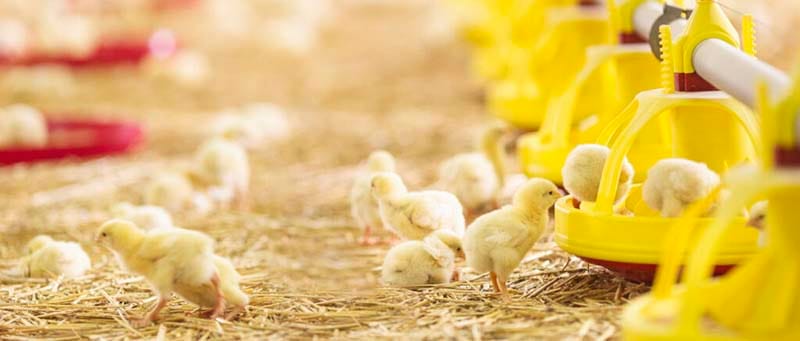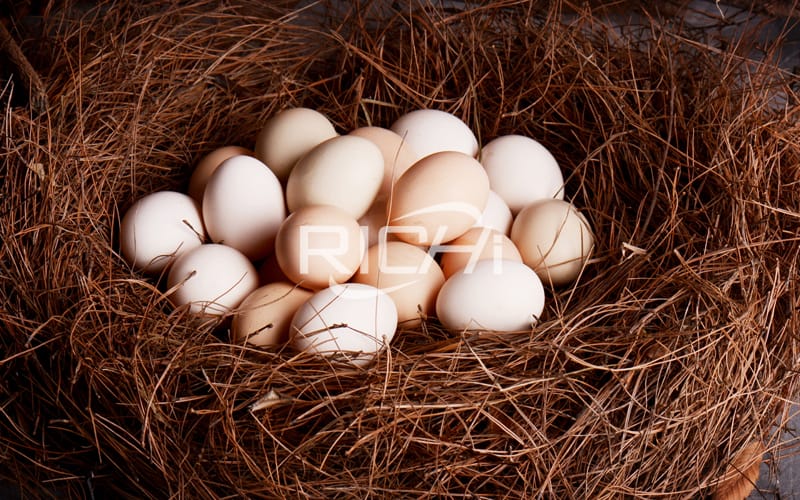The nutritional needs of laying hens with low temperature in winter are improved. The chicken house is insulated and poorly ventilated, which often results in turbid air in the house and heavy ammonia smell, which causes adverse irritation to the respiratory tract. In addition, the winter temperature is low, and the immunity of the chicken body is reduced, which makes it easy to get respiratory diseases and other infectious diseases. Therefore, according to the physiological characteristics of brown-shell layer winter nutrition, reasonable preparation of feed is of great significance for improving immunity, preventing diseases and enhancing the ability to resist the harsh external environment.

1. Basic principles of chicken feed formula for layers
(1) Scientific principles
It is the basis of feed formula design, which is mainly reflected in several aspects such as nutritional balance and palatability.
(2) Economic principles
The determination of nutritional parameters should be based on reality. The selection of feed ingredients should be based on local and time conditions, and reasonable arrangements should be made for feed processing procedures and labor consumption to reduce costs.
(3) Operability principle
Operability is the feasibility of production. The formula should be compatible with market conditions and business conditions in terms of the type of raw materials selected, the degree of quality stability, the price and the quantity. The types and stages of the products should meet the production requirements of the breeding industry, and the feasibility of the processing technology should also be considered.
(4) Market principle
The target of the product is the market. The positioning of the product must be clarified when designing the formula.
(5) Security and legality principles
Products designed according to formulas should strictly comply with national laws, regulations and regulations, such as nutritional indicators, sensory indicators, hygiene indicators, packaging, labels, etc., especially prohibited drugs cannot be used. The use or content of substances that may be harmful to animals and humans should strictly comply with national regulations. In addition, the formulation design should also consider the impact of the product on the environment and ecology.

2. Factors to be considered when formulating chicken feed making formulas
(1) Nutritional factors affecting egg production
Dietary energy level, energy-to-egg ratio, vitamin, trace element content and calcium-phosphorus ratio.
(2) Nutritional factors affecting egg weight
① Linoleic acid
Linoleic acid is involved in fat metabolism, so it affects the size of the egg through its effect on the yolk. The level of linoleic acid in the diet that guarantees the maximum egg weight is currently recognized as 1.5%.
②Energy
The growth of hens is the most sensitive to the energy concentration of the diet. Increasing the energy intake can breed new hens with a larger weight, and the laying weight is an important factor in determining the size of the egg. The influence of dietary energy level on egg weight is mainly through feed intake. Energy intake is the most critical factor affecting egg production, and protein intake is the key factor in determining egg weight.
③Protein
Protein level or more precisely protein intake is the main nutritional factor that affects egg size. Amino acid nutrition is the essence of protein nutrition.
To sum up, egg size is also a production indicator that can be adjusted within the range given by the genetic performance of the chicken breed. We can control the egg size by controlling the hen's age, body weight, protein and energy intake and other nutrients to meet market needs and maximize economic benefits.
(3) Nutritional factors affecting the color of eggshells
Generally speaking, the formation of eggshell pigment has nothing to do with the lack of a certain nutrient element, but there are indirect effects. For example, VA deficiency can cause the normal mucosal epithelium of the fallopian tube to be replaced by stratified squamous keratinized epithelium, causing malfunction.
(4) Nutritional factors affecting eggshell strength
Dietary calcium has a direct and important effect on eggshell quality. Generally, laying hens have a higher absorption of calcium in the afternoon, but there are also studies that believe that the feeding time has no relationship with the quality of the eggshell. In general diets, calcium is mainly added in the form of stone powder, and the ratios of 75% (8-10 mesh), 12.5% (10-12 mesh) and 12.25% (50 mesh) are more reasonable. When using calcium sources, attention should also be paid to the pollution of magnesium and heavy metals.
Phosphorus is closely related to calcium metabolism, and the ratio of calcium to phosphorus in the diet has a significant impact on the quality of eggshells. Low-phosphorus diets are beneficial to improve the quality of eggshells. However, if the total phosphorus level in the diet is too low, the laying performance of laying hens will decrease. High levels of phytate phosphorus in the diet will affect the quality of eggshells, but using phytase is a better solution.
Trace mineral elements can affect the quality of eggshells. Adding Ag and Cu to drinking water can improve the quality of old eggs and eggshells and reduce the rate of abnormal eggs and broken eggs, but it has no effect on young laying hens. Because manganese and zinc play an important role in the formation of carbonate and the enzyme system of protein-mucopolysaccharide synthesis, they also affect the quality of eggshells. For example, low manganese reduces the quality of eggshells per unit area and increases the ratio of cracked and broken eggs. In addition, the dietary electrolyte balance also has an impact on the quality of eggshells.
The dietary VD level is too high (3000 IU/kg) or too low (500IU/kg) will affect the quality of eggshell, the appropriate dosage is 1500 IU/kg. Without VD in the diet, egg production and eggshell quality declined rapidly, and even paralyzed chickens occurred.
Vitamin C also has an effect on the quality of eggshells. On the one hand, vitamin C can regulate calcium metabolism, and on the other hand, vitamin C can reduce the impact of stress on laying hens.
(5) Nutritional factors affecting the color of egg yolk
The liquid egg yolk is yellow, but it has different shades, ranging from light yellow to orange, which is mainly related to the type and amount of pigments it contains. The pigment in the egg yolk is mainly lutein. These pigments are mainly derived from feed. Therefore, if you feed yellow corn, alfalfa meal, dried algae, and other feeds that contain higher lutein, the yolk has a darker color, and vice versa. shallow. Lutein is soluble in lipids. Adding oil to feed is beneficial to the deposition of lutein in the yolk and increase the color of the yolk. Adding antioxidants to the feed is beneficial to prevent the oxidation of the pigment and improve the coloring effect of the pigment on the egg yolk. In laying hen production, synthetic pigments such as capsicum red, lutein, violaxanthin, and zeaxanthin are commonly used to deepen the color of egg yolk.

3. Selection of raw materials for layer feed
The best state is a plan to minimize the cost, which often requires diversification of raw materials, a large number of varieties, and flexible changes. However, due to the limitations of factors such as purchasing capacity and cost, storage capacity and cost, operation level of production workers, and the probability of errors, the raw materials need to be simple. Therefore, a better raw material selection plan is to find a balance among many factors.
(1) Choose local raw materials commonly used, and design formulas specifically
For the values of amino acids and trace elements of raw materials, refer to the "Table of Feed Ingredients and Nutritional Values" published by the Chinese feed database. For the energy value of the raw materials, because the actual measurement is difficult, it is generally not measured, and the energy estimation formula is used to estimate it. However, it must be considered that the changes in the moisture, crude ash, crude protein, and crude fiber of the raw materials may affect the energy value.
(2) Adjust the formula in time according to the price changes of raw materials
When determining the price of raw materials, it is necessary to clarify whether the raw material price is the inventory price or the market price, whether it is the predicted price or the average price. Adjust the formula in time according to the price change, which can reduce the cost of the formula.
(3) Control the content of crude fiber
The crude fiber content in the compound feed for laying hens is 2.5% to 3.5%.
(4) Control of harmful and toxic raw materials in chicken layer feed
Many feed ingredients contain some natural toxic and harmful substances. For example, rapeseed meal, cottonseed meal, etc. are not used in chicken feed, salmonella (pathogenic bacteria) should not be contained in the compound feed, and the content of heavy metals should not exceed the specified content.
(5) The volume of feed composition should be adapted to the size of the animal's digestive tract
The feed composition is too large, which can cause an overburden on the digestive tract and affect the digestion and absorption of the feed; if the volume is too small, even if the nutrients have met the needs, the animal is still hungry and in a state of restlessness, which is not conducive to its normal Growth and production.
4. The basic steps of feed formula design for layers
The feed formula for laying hens is to reasonably determine the mixing ratio of various raw materials according to the nutritional needs of the laying hens, the nutritional value of the feed, the current situation of the raw materials, the price and the climatic characteristics and other conditions. It must meet the nutritional needs of laying hens, give full play to the production performance of laying hens, and obtain products with large quantities, good quality and low cost. Therefore, when designing feed formulations for laying hens, we must understand the requirements of various nutrients and the characteristics of various feed ingredients, understand the market, conduct market research, meet market needs, and establish feed formulation design standards. Only on this basis can reasonable and scientific cooperation be carried out.
(1) Determine the use of nutrition standards
To design a feed formulation for laying hens, we must first determine the nutritional standards to be used. Determining product standards is the basis for designing feed formulations. Most feed mills adopt national standards.
(2) Determine the goal
Different production goals have different formula requirements. In addition, when formulating formulas, factors such as environmental impact and product quality should also be considered. With the change of the breeding goal, the formula design must be adjusted accordingly. Only in this way can the needs of various levels be realized.
(3) Determine the nutrient supply of animals
The breeding standards of domestic and foreign animals can be used as a basic reference for nutritional requirements. Make adjustments according to local actual conditions. The safe method is to conduct experiments first and then promote them on a large scale. At the same time, the influence of animal feed intake must be considered.
| Feeding standards for laying hens during laying period (laying rate> 85%) | |
| Raw material | Diet composition% |
| Metabolizable energy (MJ/kg) | 11.29 |
| Crude protein | 16.50 |
| Calcium | 3.5 |
| Phosphorus | 0.6 |
| Salt | 0.15 |
| Methionine | 0.34 |
| Lysine | 0.75 |
| Feeding standard for laying hens during laying period (Laying rate <85%) | |
| Nutrient content | Requirement |
| Metabolizable energy (MJ/kg) | 10.87 |
| Crude protein | 15.50 |
| Calcium | 3.5 |
| Phosphorus | 0.6 |
| Salt | 0.15 |
| Methionine | 0.32 |
| Lysine | 0.70 |
If the protein and metabolism levels are increased, the levels of calcium, phosphorus, vitamins and amino acids also need to be increased accordingly. The magnitude of the increase depends on the chicken's feed intake, generally 5%~10%.
(4) Choose feed raw materials for layer
Select available raw materials and estimate their nutrient content to determine their utilization by animals. The selection of raw materials should conform to the habits of animals and consider their biological potency.
| Metabolizable energy (MJ/kg) | Crude protein% | Calcium% | Phosphorus% | Lysine% | Methionine% | |
| Corn | 14.24 | 7.5 | 0.01 | 0.25 | 0.24 | 0.18 |
| Bran | 5.46 | 14.8 | 0.14 | 1.17 | 0.60 | 0.20 |
| Soybean meal | 9.40 | 44 | 0.25 | 0.06 | 2.9 | 0.65 |
| Cotton meal | 8.44 | 41 | 0.16 | 1.00 | 1.70 | 0.51 |
| DDGS | 9.2 | 28 | 0.2 | 0.74 | 0.59 | 0.59 |
| Rapeseed meal | 7.4 | 36 | 0.65 | 1.02 | 1.3 | 0.63 |
| Stone powder | 38 | |||||
| Shell powder | 40 |
(5) Formula design for layers
Comprehensively process the information obtained in the above three steps to form a formula. The calculation method can be manual or special computer optimized formula software.
| Feed formula and nutritional level of laying hens during laying period (laying rate> 85%) | |
| Raw material | Diet composition% |
| Corn | 55.12 |
| Bran | 1.5 |
| Soybean meal | 8.5 |
| Cotton meal | 15 |
| Rapeseed meal | 3 |
| Zeolite powder | 1.5 |
| DDGS | 5 |
| Dicalcium Phosphate | 0.6 |
| Stone powder | 5 |
| Shell powder | 3 |
| Methionine | 0.08 |
| Phytase | 0.08 |
| Salt | 0.2 |
| Sodium sulfate | 0.2 |
| Vitamins | 0.02 |
| Premix | 0.2 |
| Total | 100 |
| Nutrient content | Requirement |
| Metabolizable energy (MJ/kg) | 10.7 |
| Crude protein | 16.5 |
| Calcium | 3.3 |
| Phosphorus | 0.65 |
| Salt | 0.37 |
| Methionine | 0.345 |
| Lysine | 0.90 |
5. Features of this formula for layers
(1) A large amount of miscellaneous meal is used, which reduces the amount of soybean meal and reduces the cost.
(2) A large amount of vitamins is beneficial to improve the immunity of laying hens and reduce the incidence of disease.
(3) 1.5% zeolite powder is applied, which is beneficial to reduce the ammonia smell in the chicken house, the health of the chicken and improve the quality of the eggshell.
(4) The application of phytase not only reduces the consumption of calcium hydrogen phosphate, reduces the cost, but is also conducive to environmental protection.
[More info about feed for chicken layers]
Feed ingredient process and equipment for over 300,000 layers
How to make chicken feed for layers in chicken poultry farm?
How to configure the layer hen feed for small chicken farm
What chicken pellet feed do layer hens like to eat?
Eat complete formula chicken feed to reduce cost of layer chicken feed making plant
3T/H full automatic chicken feed mill plant for making layer feed
Is it okay not to use chicken feed additives when raising layers?


